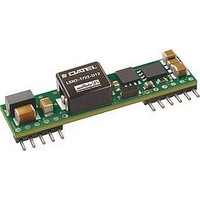LSN2-T/22-D12NG-C Murata Power Solutions Inc, LSN2-T/22-D12NG-C Datasheet - Page 7

LSN2-T/22-D12NG-C
Manufacturer Part Number
LSN2-T/22-D12NG-C
Description
DC/DC Converter
Manufacturer
Murata Power Solutions Inc
Series
LSN2r
Specifications of LSN2-T/22-D12NG-C
No. Of Outputs
1
Input Voltage
8.3V To 14V
Power Rating
112W
Output Current
22A
Approval Bodies
UL, CSA
Supply Voltage
14VDC
Dc / Dc Converter Case Style
SIP
Dc/dc Converter Mounting
Through Hole
Product
Non-Isolated / POL
Output Power
110 W
Input Voltage Range
8.3 V to 14 V
Input Voltage (nominal)
12 V
Number Of Outputs
1
Output Voltage (channel 1)
0.8 V to 5 V
Output Current (channel 1)
22 A
Package / Case Size
SIP
Output Type
Low Voltage Selectable
Output Voltage
0.8 V to 5 V
Lead Free Status / RoHS Status
Lead free / RoHS Compliant
The highest temperatures in LSN2 SIPs occur at their output inductor, whose
heat is generated primarily by I
using thermocouples to monitor the inductor temperature and varying the load
to keep that temperature below +110°C under the assorted conditions of air
fl ow and air temperature. Once the temperature exceeds +115°C (approx.),
the thermal protection will disable the converter. Automatic restart occurs
after the temperature has dropped below about +110°C.
As you may deduce from the derating curves and observe in the effi ciency
curves on the following pages, LSN2 SIPs maintain virtually constant
effi ciency from half to full load, and consequently deliver very impressive
temperature performance even if operating at full load.
Lastly, when LSN2 SIPs are installed in system boards, they are obviously
subject to numerous factors and tolerances not taken into account here. If you
are attempting to extract the most current out of these units under demand-
ing temperature conditions, we advise you to monitor the output-inductor
temperature to ensure it remains below +110°C at all times.
Pre-Biased Startup
Newer systems with multiple power voltages have an additional problem
besides startup sequencing. Some sections have power already partially
applied (possibly because of earlier power sequencing) or have leakage power
present so that the DC/DC converter must power up into an existing voltage.
This power may either be stored in an external bypass capacitor or supplied
by an active source.
This “pre-biased” condition can also occur with some types of program-
mable logic or because of blocking diode leakage or small currents passed
through forward biased ESD diodes. Conventional DC/DC’s may fail to start up
correctly if there is output voltage already present. And some external circuits
are adversely affected when the low side MOSFET in a synchronous rectifi er
converter sinks current at start up.
The LSN2 series includes a pre-bias startup mode to prevent these initializa-
tion problems. Essentially, the converter acts as a simple buck converter until
the output reaches its set point voltage at which time it converts to a synchro-
nous rectifi er design. This feature is variously called “monotonic” because
the voltage does not decay (from low side MOSFET shorting) or produce a
negative transient once the input power is applied and the startup sequence
begins.
Don’t Use Pre-Biasing and Sequencing Together
Normally, you would use startup sequencing on multiple DC/DC’s to solve the
Pre-Bias problem. By causing all power sources to ramp up together, no one
source can dominate and force the others to fail to start. For most applica-
tions, do not use startup sequencing in a Pre-Bias application, especially with
an external active power source.
If you have active source pre-biasing, leave the Sequence input open so that
the output will step up quickly and safely. A symptom of this condition is
repeated failed starts. You can further verify this by removing the existing load
and testing it with a separate passive resistive load which does not exceed full
current. If the resistive load starts successfully, you may be trying to drive an
external pre-biased active source.
It may also be possible to use pre-bias and sequencing together if the Pre-
Bias source is in fact only a small external bypass capacitor slowly charged by
leakage currents. Test your application to be sure.
2
R losses. The derating curves were developed
www.murata-ps.com
Output Adjustments
The LSN2 series includes a special output voltage trimming feature which
is fully compatible with competitive units. The output voltage may be varied
using a single trim resistor from the Trim input to Power Common (pin 4)
or an external DC trim voltage applied between the Trim input and Power
Common.
As with other trim adjustments, be sure to use a precision low-tempco resis-
tor (±100 ppm/°C) mounted close to the converter with short leads. Also be
aware that the output voltage accuracy is ±2% (typical) therefore you may
need to vary this resistance slightly to achieve your desired output setting.
Resistor Trim Equation:
Voltage Trim
The LSN2 Series may also be trimmed using an external voltage applied
between the Trim input and Output Common. Be aware that the internal “load”
impedance looking into trim pin is less than 5k:. Therefore, you may have to
compensate for this in the source resistance of your external voltage refer-
ence.
Use a low noise DC reference and short leads. Mount the leads close to the
converter. Consider using a small bypass capacitor (0.1μF ceramic) between
trim and output common to improve stability.
Voltage Trim Equation:
The LSN2 fi xed trim voltages to set the output voltage are:
R
V
V
V
TRIM
TRIM
OUT
OUT
(k:)
(V)
V
TRIM
Open
Open
0.8V
0.8V
R
TRIM
(in Volts) = 0.7 –(0.0667 x (V
22A Selectable-Output DC/DC Converters
(:) = _____________ –1000
41.424
0.6835
1.0V
1.0V
Figure 6. Trim Connections
25 Jun 2010
V
22.46
0.670
1.2V
1.2V
O
– 0.7525
10500
LSN2-T/22-D12
13.05
0.650
1.5V
1.5V
MDC_LSN2-T/22-D12_B03Δ
Non-isolated, DOSA-SIP,
O
9.024
0.630
– 0.7525))
1.8V
1.8V
email: sales@murata-ps.com
5.009
0.583
2.5V
2.5V
3.122
0.530
3.3V
3.3V
Page 7 of 13
0.4166
1.472
5V
5V






















